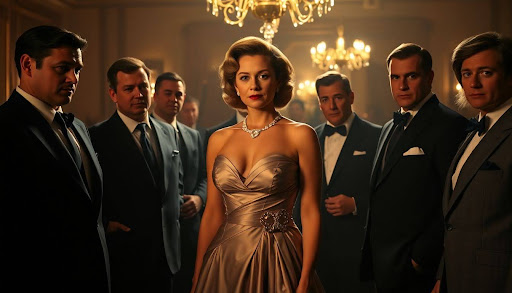The Women by Kristin Hannah: A Powerful Look at Women in the Vietnam War
In The Women, Kristin Hannah tells a gripping story that brings to light the sacrifices and challenges faced by women during the Vietnam War. This historical fiction centers on Frances “Frankie” McGrath, a young nurse who joins the Army Nurse Corps, highlighting the often hidden experiences of women in a war that reshaped lives and futures.
As readers, you’ll discover the profound impact of war—not just on soldiers, but on those who care for them. The novel doesn’t shy away from the haunting realities of trauma and the struggle for recognition faced by female veterans. It weaves a narrative rich with friendship, resilience, and the quest for healing in a world quick to forget.
Whether you’re a seasoned reader or just starting out, The Women offers a powerful and intimate look at a crucial yet overlooked chapter in history. Join Frankie on her journey and witness the strength of women who fought not only against external battles but also within themselves.
Overview of the Plot
The Women unfolds through the life of Frances “Frankie” McGrath, exploring her transformation and experiences amidst the backdrop of the Vietnam War. This complex narrative emphasizes both the personal struggles and historical realities faced by women in a male-dominated environment. Readers are taken on a journey to understand not only the plot’s intricacies but also the emotional depth that accompanies Frankie’s story.
Main Character: Frances ‘Frankie’ McGrath
Frankie McGrath comes from a privileged background, shaped by both the expectations and limitations that often accompany wealth. Raised in a family that values tradition, she grapples with societal norms that dictate a woman’s role. Her decision to enlist in the Army Nurse Corps marks a pivotal moment in her life, reflecting her desire to break free from the constraints of her upbringing. Frankie seeks purpose and adventure, yearning to contribute to something larger than herself.
As she steps into her role as a nurse during the war, she faces challenges that test her resilience and compassion. The psychological toll of treating injured soldiers proves to be a profound challenge, one that reshapes her understanding of sacrifice and duty. Frankie’s journey isn’t just about war; it’s about finding her voice and identity in a tumultuous world. For more about her character development, check this link: Recap, Summary + Review: The Women by Kristin Hannah.
Setting: Vietnam War Era
The story is set during the Vietnam War, a period fraught with conflict and controversy. This war, which lasted from 1955 to 1975, was marked by significant political and social upheaval. Thousands of troops were sent overseas, while protests erupted across the United States. The Vietnam War era deeply influences the narrative, shaping the characters and their experiences. The harsh realities of combat, the sounds of helicopters, and the cries of the wounded create an atmosphere of chaos and urgency.
For women like Frankie, the Vietnam War was an opportunity to serve their country while battling ongoing gender discrimination. They faced not only physical danger but also the struggle for recognition and respect in a male-dominated military. The psychological impact of war extended beyond the battlefield, affecting families and communities back home. This historical context gives The Women its emotional weight, entwining personal stories with the broader societal implications of the war. For a deeper understanding of this era, you can read more about it here: Vietnam War: Causes, Facts & Impact.
Themes Explored in The Women
Kristin Hannah’s The Women dives into several compelling themes that resonate deeply with readers. These themes not only enhance the narrative but also reflect relevant societal issues, particularly those regarding female veterans. Let’s explore some of the most prominent themes within the novel.
Female Camaraderie and Support
In The Women, friendships among women serve as a powerful lifeline. The bond between Frankie and her fellow nurses showcases the strength derived from camaraderie. These women face overwhelming challenges together, sharing both their fears and triumphs. Their collective experiences amplify their resilience, proving that support from one another can be a source of healing.
Friendship in the novel often highlights how women navigate personal trauma while serving a greater cause. Instead of isolation, they find solace in each other, creating a sisterhood that makes the harsh realities of war more bearable. This theme emphasizes that, whether in times of conflict or peace, the connections formed between women can foster strength and hope. For more on this theme, check out this review: Book Review: The Women by Kristin Hannah.
The Struggle with PTSD
Another central theme in The Women is the struggle with post-traumatic stress disorder (PTSD), a condition faced by many veterans. The novel effectively captures the psychological toll of warfare, shedding light on how trauma can linger long after the fighting stops.
Frankie’s character experiences firsthand the intense mental and emotional challenges tied to her service. The narrative explores the complexities of PTSD, illustrating how it can affect veterans’ daily lives, relationships, and sense of self. This theme invites readers to engage with the realities of mental health struggles, fostering a greater understanding of its implications. For a deeper look at PTSD in veterans, visit this source: Post-traumatic Stress Disorder in Veterans.
Societal Dismissal of Women’s Experiences
The novel also critiques the societal dismissal of the experiences of women veterans. Despite their vital contributions during the Vietnam War, many female veterans face a lack of recognition and respect. The Women confronts this issue head-on, illustrating how society often overlooks their sacrifices and struggles.
Women like Frankie are not just fighting for their country on the battlefield; they also encounter battles for their voices to be heard in the civilian world. The book highlights the challenges of being a female veteran, including the stigma and biases they commonly face. This exploration encourages readers to reflect on broader societal attitudes toward women who serve in the military. For more on this topic, you can read about the recognition issues here: Dispelling the myths of Women Veterans Recognition Day.
Through these themes, The Women offers a gripping narrative that connects deeply with readers, inviting them to empathize with the untold stories of female veterans while emphasizing the importance of solidarity, mental health awareness, and recognition.
Character Development
In The Women, character development is at the heart of the story. The transformation of Frances “Frankie” McGrath offers readers a compelling look at how war can change a person. From her sheltered life in California to the battlefield, readers witness the profound effects of combat on her character and relationships.
Frankie’s Journey from California to Combat: Trace her transformation from a sheltered life to the realities of war.
Frankie starts as a young woman bound by societal expectations and family obligations. Her life in California is comfortable but narrow, limiting her experiences and aspirations. As she decides to join the Army Nurse Corps, she’s propelled out of her familiar surroundings. This choice signifies her desire to explore her identity and purpose.
Upon arriving in Vietnam, Frankie encounters the stark realities of war. She faces life-and-death situations, emotional stress, and the burden of caring for injured soldiers. These experiences force her to confront her limitations and grow in unexpected ways. Each challenge she faces, whether it’s treating a severely wounded soldier or grappling with the chaos around her, shapes her resilience and depth.
As the war progresses, Frankie’s transformation becomes evident. She evolves from a sheltered nurse into a confident and capable woman. The war strips away her naivety and reveals her strength, but it also exposes her to trauma. Struggling with her newfound identity amidst the horrors of combat, she learns essential lessons about compassion, sacrifice, and the complexities of human nature. For a deeper understanding of character development, you can check this link: Character Development in Literature.
Impact of War on Relationships: Explore how war affects Frankie’s relationships with family and friends.
War doesn’t just challenge Frankie physically; it deeply affects her relationships. As she immerses herself in her role, the distance between her and her family grows. Her loved ones have a hard time understanding her experiences and emotions. The letters exchanged with her family become lifelines, but they also highlight the gulf created by war.
Frankie’s friendship with her fellow nurses is instrumental in her journey. They form a sisterhood forged in shared trials and support. Together, they navigate their fears and heartbreak, which becomes essential for survival in such a harsh environment. Their bond illustrates how relationships can flourish under duress. Through shared laughter and tears, they create a sense of home amid the chaos.
However, the impact of war reaches beyond these connections. When Frankie returns home, she finds that her relationships have fundamentally changed. Friends and family may not recognize the person she has become. The emotional scars of war can be invisible, leading to misunderstandings and a struggle to reconnect. The novel poignantly depicts these challenges and the effort necessary to rebuild bonds after experiencing trauma. For more insight into this topic, you can read about the impact of war on relationships here: The Impact of War on Literature and Storytelling.
Writing Style and Structure
Kristin Hannah’s writing style in The Women stands out for its vividness and emotional depth. She utilizes language not merely to tell a story but to transport readers into the heart of the Vietnam War experience. Through her skilled narration, Hannah emphasizes the significance of various elements such as imagery and pacing, shaping how the story resonates with readers.
Use of Vivid Imagery: Describe how imagery plays a role in depicting the war experience.
Imagery is central to Hannah’s storytelling. She paints scenes with precise details that engage the senses, making the reader feel the weight of every moment. For instance, the sights and sounds of a battlefield—helicopters thundering overhead, the cries of wounded soldiers—intensely depict the chaos of war. This attention to sensory detail immerses readers in the reality of Frankie’s experiences, allowing them to feel her fear and determination.
Consider how Hannah describes the jungle. She uses lush imagery to create a stark contrast between the beauty of nature and the brutality of war. Readers can almost visualize the vibrant greens and hear the rustling leaves, creating a haunting backdrop against the struggles Frankie faces. This blend of picturesque and grim elements enhances the emotional impact of the narrative.
Imagery also plays a pivotal role in illustrating the psychological weight of Frankie’s journey. Hannah often describes not only the physical wounds of soldiers but also the emotional scars borne by her characters. These detailed portrayals resonate powerfully, paving the way for readers to empathize with their struggles, making the experience more relatable and poignant. For more about the importance of imagery in literature, check out this insightful discussion: An Interview with Kristin Hannah | The Blog.
Narrative Flow and Pacing: Assess the pacing of the story and its effect on reader engagement.
Pacing in The Women is deliberate and effectively builds tension. The story moves between periods of intense action and quieter, reflective moments, giving readers time to process the emotional weight of war. This ebb and flow keep readers engaged, as they are drawn into the high-stakes situations Frankie’s facing while also being invited to understand her internal struggles.
Hannah uses short, punchy sentences during moments of action, creating a sense of urgency and immediacy. In contrast, during reflective passages, she employs longer, more descriptive sentences, allowing readers to absorb the gravity of Frankie’s experiences. This variation in pacing enhances the overall reading experience, engaging readers in both the external events and internal conflicts that define the characters’ journeys.
Moreover, Hannah’s chapter structure contributes to the pacing. Each chapter ends with a slight cliffhanger or a contemplative moment, prompting readers to continue. This strategy keeps the narrative moving forward and maintains a level of intrigue that encourages readers to turn the pages. Overall, the pacing captures the chaotic rhythm of war while emphasizing the emotional gravity of the story. For an exploration of narrative structure, you may find this article about writing structure insightful: Women’s Fiction Spotlight: Kristin Hannah.
Reader Reception and Critiques
The Women by Kristin Hannah has stirred strong reactions among readers and critics alike. The blend of historical context and emotional depth has garnered an extensive range of reviews. Let’s break down the key points from positive reviews and common critiques to better understand how the book has been received.
Positive Reviews and Praises
Many readers have praised The Women for its compelling narrative and vivid character development. Key points highlighted in reviews include:
- Emotional Resonance: Readers often mention the emotional depth of the characters, particularly how Frankie’s experiences resonate on a personal level. Reviewers express that the book captures the challenges women faced during the Vietnam War and the lasting effects of trauma. For instance, the New York Times notes how Hannah’s storytelling draws readers into the raw reality of the characters’ lives.
- Strong Themes of Camaraderie: The themes of female friendship and support
Conclusion
The Women by Kristin Hannah leaves a remarkable imprint on readers, shining a light on the often-ignored experiences of women in the Vietnam War. Through Frankie’s journey, the novel uncovers themes of resilience, friendship, and the impact of trauma, offering a poignant reflection on the past and its relevance in today’s world.
This compelling story encourages a deeper understanding of the sacrifices made by female veterans and the importance of acknowledging their struggles. It prompts us to consider how societal attitudes toward women in service have evolved and what more can be done to honor their contributions.
If you’re looking for a book that combines historical depth with emotional resonance, The Women is a must-read. What do you think about the portrayal of women during wartime? Share your thoughts and let’s spark a conversation about their stories.







